|
|
|
Sort Order |
|
|
|
Items / Page
|
|
|
|
|
|
|
| Srl | Item |
| 1 |
ID:
124552
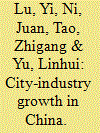

|
|
|
|
|
| Publication |
2013.
|
| Summary/Abstract |
This paper investigates the relevance of two leading theories of city-industry growth (i.e., specialization and diversity theories) in accounting for the fast yet uneven growth of industries in China's cities. Using a comprehensive dataset of manufacturing industries in 231 China's cities for the period 1998-2005, we find that specialization promotes city-industry growth, whereas diversity has no effect at all. In addition, we find that specialization is important for the growth of mature industries in China, but diversity is crucial for the development of China's relatively new and fast-growing industries. Our study contributes to the literature by examining the relevance of the specialization and diversity theories for a large and fast-growing developing economy.
|
|
|
|
|
|
|
|
|
|
|
|
|
|
|
|
| 2 |
ID:
085411
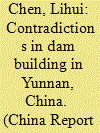

|
|
|
|
|
| Publication |
2008.
|
| Summary/Abstract |
When choosing the site of a dam, meeting the needs of the resettled local communities should be a key criterion in making any decision to build a dam. On the basis of a pilot study in Yunnan, China, this article finds that neither displacement into the area surrounding the dam nor movement to other towns, can meet the needs of the communities displaced by dams. This is because: (a) ideal areas for dam building often do not coincide with the factors necessary to restore the economy of the resettlement communities; and (b) cultural diversity exacerbates the impacts of displacement by a dam. It is concluded that overcoming the limitations of the contradictions between dam construction and resettlement is difficult. More work is needed on the resettlements in Yunnan. The cultural dimensions should be taken into consideration before further decisions on dam building and resettlement are made.
|
|
|
|
|
|
|
|
|
|
|
|
|
|
|
|
| 3 |
ID:
092520
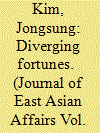

|
|
|
| 4 |
ID:
124546
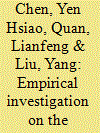

|
|
|
|
|
| Publication |
2013.
|
| Summary/Abstract |
This paper employs a structural time series model designed with three components of stochastic seasonality, trigonometric expression of cyclicality and local linear trend to investigate the evolutionary process of China's GDP. In particular, the model is able to detect the stop-go feature of China's economic growth, i.e., growth cycle, as well as business cycle. The empirical result suggests that most variation in China's macroeconomic performance came from business cycle. The investigation of the three components along with historical events suggests that the Chinese economy had been largely influenced by political activities up to the early 1990s. In the mid-1990s China entered a period of stable and highly growing economy, thanks to the economic reform and the successful implementation of macroeconomic policies. However, since the mid-2000s China has become more sensitive to the turbulences in international markets. In the foreseeable future, the challenge facing China is a more volatile economy with possible slowdown in the economic growth, although the growth rate would still be high compared to developed economies.
|
|
|
|
|
|
|
|
|
|
|
|
|
|
|
|
| 5 |
ID:
127772
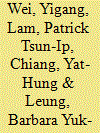

|
|
|
|
|
| Publication |
2014.
|
| Summary/Abstract |
To curb price speculations and overheated investment in the real estate market, the mainland Chinese government has determined to tighten bank lending to the market in recent years, by resorting to administrative tools through specific real estate control policy. With hindsight, the market response seems to have invalidated the policy initiatives. This research is aimed at investigating the impediments to achieving the laudable policy objectives of using administrative credit controls. A series of research interviews with property practitioners unraveled prevalent evasive practices and illicit tactics adopted by developers to thwart policy effects. This study leads to a better understanding of the institutional backdrop behind the less-than-expected results of the real estate macro-control measures. To better steer the real estate market, effective monetary control requires both the government and industry to make concerted efforts and consistent headway towards a complete, transparent and responsive ensemble of institutional arrangements.
|
|
|
|
|
|
|
|
|
|
|
|
|
|
|
|
| 6 |
ID:
127773
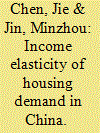

|
|
|
|
|
| Publication |
2014.
|
| Summary/Abstract |
Since 1998, the Chinese housing market has played a fundamental role in driving macroeconomic stability and economic growth. This paper attempts to estimate the income elasticity of housing demand in Shanghai based on a household survey conducted by the National Bureau of Statistics of China in 2007. We utilize a two-stage model, which integrates analysis of both tenure choice and housing demand. Our findings indicate that both permanent and current income has significant influence on tenure choice in Shanghai, and that owner-occupiers' permanent income elasticity of housing demand in Shanghai is between 0.375 and 0.447. Our research also suggests that migrant homeowners have higher permanent income elasticity than Shanghai natives and that most Chinese households are liquidity constrained with regards to obtaining homeownership. We also find that permanent income elasticity increases with age. Finally, the existence of an urban-rural and regional difference is shown.
|
|
|
|
|
|
|
|
|
|
|
|
|
|
|
|
| 7 |
ID:
124551


|
|
|
|
|
| Publication |
2013.
|
| Summary/Abstract |
This paper addresses the relationship between bank competition and efficiency by computing Lerner indices and cost efficiency scores for a sample of Chinese banks over the period 2002-2011. Granger-causality tests are performed in a dynamic GMM panel estimator framework to evaluate the sign and direction of causality between them. We observe no increase in bank competition over the period, even as cost efficiency improves. In a departure from the empirical literature showing that competition negatively Granger-causes cost efficiency for Western banks, we find no significant relation between competition and efficiency. This suggests that measures to increase bank competition in the Chinese context are not detrimental to efficiency.
|
|
|
|
|
|
|
|
|
|
|
|
|
|
|
|
| 8 |
ID:
124891
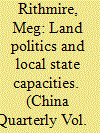

|
|
|
|
|
| Publication |
2013.
|
| Summary/Abstract |
Despite common national institutions and incentives to remake urban landscapes to anchor growth, generate land-lease revenues and display a capacious administration, Chinese urban governments exhibit varying levels of control over land. This article uses a paired comparison of Dalian and Harbin in China's north-east to link differences in local political economies to land politics. Dalian, benefiting from early access to foreign capital, consolidated its control over urban territory through the designation of a development zone, which realigned local economic interests and introduced dual pressures for enterprises to restructure and relocate. Harbin, facing capital shortages, distributed urban territory to assuage the losers of reform and promote economic growth. The findings suggest that 1) growth strategies, and the territorial politics they produce, are products of the post-Mao urban hierarchy rather than of socialist legacies, and 2), perhaps surprisingly, local governments exercise the greatest control over urban land in cities that adopted market reforms earliest.
|
|
|
|
|
|
|
|
|
|
|
|
|
|
|
|
| 9 |
ID:
124405
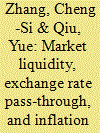

|
|
|
|
|
| Publication |
2013.
|
| Summary/Abstract |
This paper examines the effects of market liquidity and exchange rate pass-through on domestic inflation in China from 1998 to 2008 using both univariate and multivariate dynamic models. We find the following: (1) market liquidity in China has significantly positive effects on inflation, (2) the pass-through effect of exchange rates is limited to CPI. (3) the shock to growth rate of real GDP drives domestic inflation significantly, (4) external shocks contribute little to the volatility of inflation, and (5) China s central bank should keep the growth rate of M2 as the main monetary policy instrument in inflation management.
|
|
|
|
|
|
|
|
|
|
|
|
|
|
|
|
| 10 |
ID:
124558
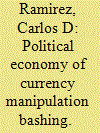

|
|
|
|
|
| Publication |
2013.
|
| Summary/Abstract |
In recent years, one of the most frequently debated issues in Congress has been the value of the Chinese renminbi (RMB) relative to the U.S. dollar. Many members of Congress often accuse China of being a "currency manipulator." This paper has two objectives. First, it investigates the extent to which PAC contributions from key interest groups as well as constituent interests influence the frequency with which members of Congress criticize China's exchange rate policy, controlling for other factors. The results indicate that the odds that a congressman will call China a "currency manipulator" are 1.35 times higher for every $5000 in PAC contributions from groups that favor legislation against China. In addition, the results show that a one percentage point increase in the share of the congressional district labor force in manufacturing is associated with a 19.6% increase in the likelihood that the district's legislator will label China a "currency manipulator." Second, this paper investigates the consequences that "currency manipulation" bashing may have on the rate at which the RMB appreciates against the U.S. dollar. The results for a VAR model indicate that an increase in the incidence of "currency manipulation" bashing appears to temporarily slow down, rather than accelerate, the rate at which the renminbi appreciates against the dollar. This result suggests that bashing China may actually be counterproductive.
|
|
|
|
|
|
|
|
|
|
|
|
|
|
|
|
| 11 |
ID:
084741
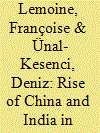

|
|
|
|
|
| Publication |
2008.
|
| Summary/Abstract |
China and India are two demographic giants that have become big developing economic powers. They have maintained their specialization in textiles and developed outward-oriented sectors linked to new technologies, taking advantage of offshoring and outsourcing. Their increasing contribution to international trade is changing the world supply and demand of manufactured goods, primary goods and services. They are new leaders in the international division of labor, but beyond technological catch-up, their challenge is quality upgrading. Both countries are increasingly contributing to global economic growth, but they cannotyet trigger the growth of the rest of the world by themselves
|
|
|
|
|
|
|
|
|
|
|
|
|
|
|
|
|
|
|
|
|